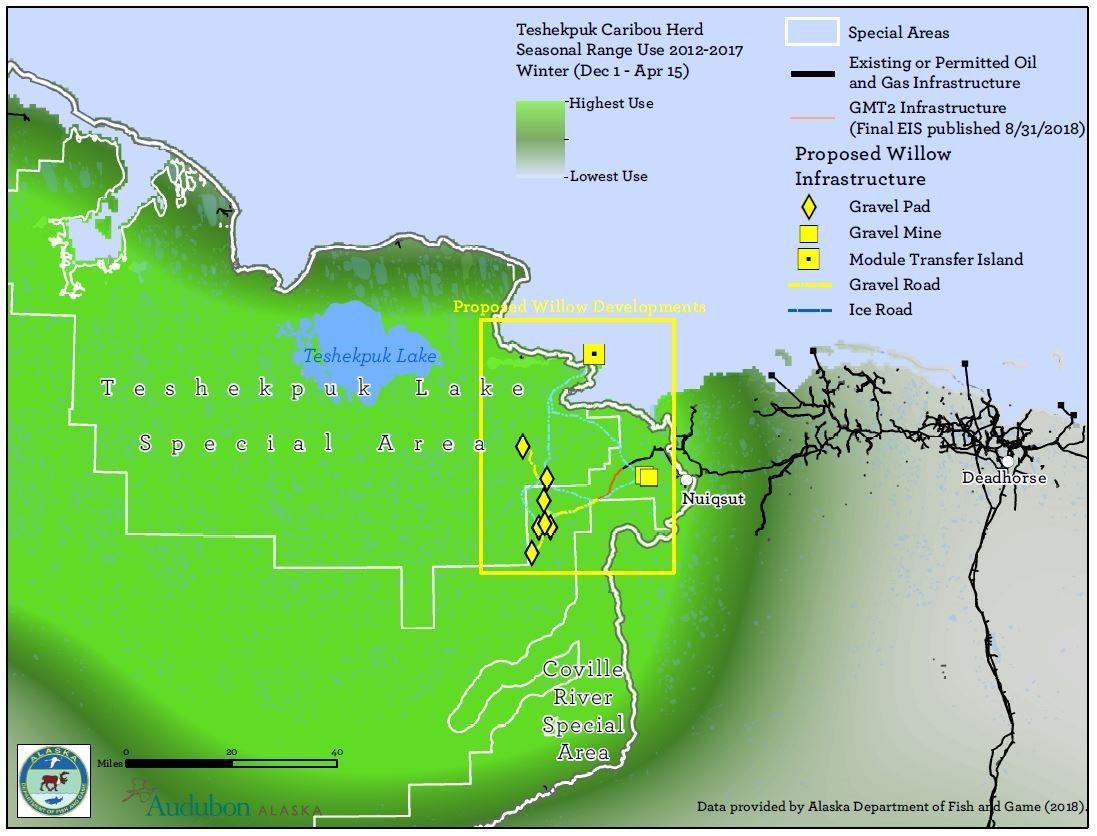During winter, caribou are focused on finding food to last until the spring thaw. During the summer, caribou eat a variety of tasty green vegetation. During the winter, caribou must dig and scrape away the snow to uncover lichens, which are tough and fibrous but provide the energy to endure Arctic conditions. Some scientists have pointed out that climate change could reduce lichens and increase the amount of ice covering the snow, making it more difficult for caribou to dig beneath the snow.
Most caribou leave the Arctic Coastal Plain in the winter, migrating south to find less frigid wintering habitat. But over half of the caribou from the Teshekpuk Caribou Herd remain near the Coastal Plain and tough it out during the cold Arctic winter. These caribou are hanging out in temperatures that regularly hit 20 or 30 degrees below zero! Check out the map to see where they spend their time in the winter.

Oil and gas development will increasingly overlap with wintering habitat for the Teshekpuk Caribou Herd. Existing infrastructure, shown as black lines on the map, has already started to overlap with the eastern edge of their seasonal habitat. The red and yellow lines show where planned and proposed infrastructure will reach deeper into their usual wintering areas.
Winter is construction season for oil companies in the central Arctic. They extract water from ponds and lakes and spray it on the tundra to build ice roads. The result is a bustling network of trucks hauling materials, drill rigs, and people back and forth across the tundra. In areas where oil companies are searching for oil reservoirs, giant seismic vehicles roll across the frozen ground, blasting sound waves deep into the earth to map out underground geology. Until now, this exploration and construction has mostly happened in areas where the caribou have migrated south. It is not yet known what winter activity will mean for the caribou that remain in the Coastal Plain, trying their best to find lichen beneath the snow during winter months.
The pace at which development is entering into the NPR-A does not give us much time to study this problem. The oil company ConocoPhillips announced it will build a new oil project this winter featuring up to 48 oil wells. A big new Master Development Plan is slated to receive fast-tracked environmental review. On top of all these new developments, the Department of the Interior has now announced it will redo the entire land management plan for the NPR-A, potentially throwing out long-standing protections for caribou habitat in favor of oil and gas. The wintering individuals from the Teshekpuk Caribou Herd are already living lichen-to-mouth and enduring added pressures from climate change. Impacts to wintering caribou is one of Audubon’s concerns as we face increased oil and gas activity in the Western Arctic.
This is the final installment of our three-part series exploring the caribou data in comparison to expanded oil and gas activity in the Western Arctic. We have seen how the protected areas around Teshekpuk Lake provide habitat for caribou at all stages of their life. These same areas also provide habitat for molting geese, nesting loons, and over half a million shorebirds. Join us as we fight to protect this vitally important safe haven for birds and other wildlife.
Taking a Closer Look at the Teshekpuk Caribou Herd: Part One, Spring Calving
Taking a Closer Look at the Teshekpuk Caribou Herd: Part Two, Fall Migration



